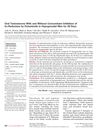Search
for
Sort by
Research
240-270 / 1000+ results
research In Vitro and Ex Vivo Hair Follicle Models to Explore Therapeutic Options for Hair Regeneration
New methods to test hair growth treatments have been developed.

research Dermal Papilla Cell Number Specifies Hair Size, Shape, and Cycling, and Its Reduction Causes Follicular Decline
More dermal papilla cells in hair follicles lead to larger, healthier hair, while fewer cells cause hair thinning and loss.

research Hair Growth Induction: Roles of Growth Factors
EGF and FGF help hair growth by affecting cell differentiation and fiber growth.

research Alopecia: A Pathologist's View
The review concludes that accurate diagnosis of different types of hair loss requires proper biopsy techniques and understanding the hair growth cycle and underlying causes.

research Oral Testosterone With and Without Concomitant Inhibition of 5α-Reductase by Dutasteride in Hypogonadal Men for 28 Days
Taking oral testosterone with or without dutasteride increases testosterone levels and could be an effective treatment for low testosterone.

research The Prevalence of Polycystic Ovary Syndrome in a Normal Population According to the Rotterdam Criteria Versus Revised Criteria Including Anti-Mullerian Hormone
Adding anti-Müllerian hormone to PCOS criteria lowers the number of women diagnosed.

research Cutaneous Scarring: Basic Science, Current Treatments, and Future Directions
New effective scar treatments are urgently needed due to the current options' limited success.

research Theoretical Considerations in Laser Hair Removal
Laser hair removal effectiveness depends on targeting hair structures without harming the skin, and improvements require more research and expert collaboration.

research The Pathogenesis of Alopecia Areata
Alopecia areata is likely caused by a combination of genetic factors and immune system dysfunction, and may represent different diseases with various causes.

research Hardwiring Stem Cell Communication Through Tissue Structure
The conclusion is that tissue structure is key for stem cell communication and maintaining healthy tissues.

research Effect of 5α-Dihydrotestosterone and Testosterone on Apoptosis in Human Dermal Papilla Cells
High levels of testosterone and 5α-DHT can lead to cell death in cells important for hair growth.

research EEMCO Guidance for the Assessment of Hair Shedding and Alopecia
The document explains hair growth and shedding, factors affecting it, and methods to evaluate hair loss, emphasizing the importance of skin biopsy for diagnosis.

research Peripheral Skin Temperature and Circadian Biological Clock in Shift Nurses After a Day Off
Shift nurses show altered body temperature and stress hormone levels, suggesting their body clocks adjust to irregular schedules.

research Distribution of Extracellular Matrix Molecules in Human Hair Follicles
ECM molecules are crucial for hair growth and development.

research Macroenvironmental Regulation of Hair Cycling and Collective Regenerative Behavior
Hair growth is influenced by various body and external factors, and neighboring hairs communicate to synchronize regeneration.

research Electrospun Fibrous Sponge via Short Fiber for Mimicking 3D Extracellular Matrix
The 3D electrospun fibrous sponge is promising for tissue repair and healing diabetic wounds.

research Topical Application of Oleuropein Induces Anagen Hair Growth in Telogen Mouse Skin
Olive leaf compound oleuropein helps grow hair in mice.

research A Bald Statement: Current Approaches to Manipulate Miniaturization Focus Only on Promoting Hair Growth
The conclusion is that future hair loss treatments should target the root causes of hair thinning, not just promote hair growth.

research Anatomy of the Ageing Face
The document concludes that understanding the anatomical changes of the ageing face is important for effective rejuvenation treatments.

research The Topography of Fibrous Scaffolds Modulates the Paracrine Function of Adipose-Derived Mesenchymal Stem Cells in the Regeneration of Skin Tissues
The shape of fibrous scaffolds can improve how stem cells help heal skin.

research Alopecia Areata: Gene Expression in Skin Samples from Patients
Alopecia areata involves immune response and gene changes affecting hair loss.

research Laser Hair Removal: Efficacy and Challenges
Laser hair removal works well for people with dark hair and light skin, but it's less effective for light hair or dark skin; improvements are expected.

research The Etiology and Pathogenesis of Alopecia Areata
The cause of alopecia areata is likely a mix of genetics, immune system issues, and environmental factors, with more research needed to understand it fully.

research Improving Posttraumatic Facial Scars
The document concludes that improving the appearance of posttraumatic facial scars is possible with careful treatment and realistic expectations.

research Integral Roles of Specific Proteoglycans in Hair Growth and Hair Loss: Mechanisms Behind the Bioactivity of Proteoglycan Replacement Therapy with Nourkrin with Marilex in Pattern Hair Loss and Telogen Effluvium
Proteoglycans are important for hair growth, and a specific treatment can help reduce hair loss.

research LncRNA-599547 Contributes to the Inductive Property of Dermal Papilla Cells in Cashmere Goats Through miR-15b-5p/Wnt10b Axis
A specific RNA in cashmere goats helps improve hair growth by interacting with certain molecules.

research How a Bird Gets Its Feathers: Insights from Chromatin Looping
Feather patterns are influenced by enhancers and chromatin looping, and the structure of protein complexes important for hair growth has been detailed.

research In Silico Study on the Contribution of the Follicular Route to Dermal Permeability of Small Molecules
Hair follicles affect how well small molecules can pass through the skin, and this varies depending on the molecule's features.

research Genome Scan for Signatures of Adaptive Evolution in Wild African Goat (Capra Nubiana)
Wild African goats have genetic adaptations for surviving harsh desert conditions.